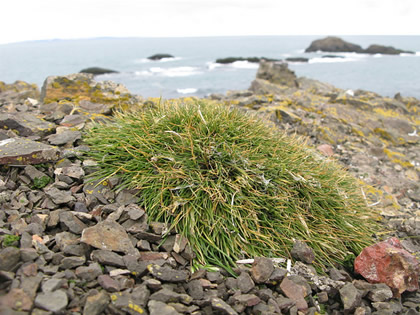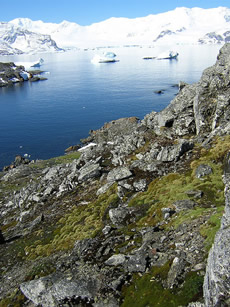Agriculture
The harsh climate of Antarctica makes it one of the most inhospitable places on the earth, allowing only a relatively small number of organisms to live there. Permanent terrestrial (land) animals and plants are few and small. There are no trees, shrubs, or vertebrate land animals. Native organisms are hardy, yet the ecosystem is fragile and easily disturbed by human activity, pollution, global warming, and ozone layer depletion.
The Antarctic continent has never had a native or permanent population of humans. In 1998 the United States, Russia, Belgium, Australia, and several other countries signed one of an ongoing series of treaties to preserve Antarctica. The continent is used for peaceful international endeavors such as scientific research and ecotourism.
Terrestrial Flora
There are only two types of flowering plants in Antarctica, a grass and a small pearlwort (Deschampsia antarctica). These are restricted to the more temperate Antarctic Peninsula. Antarctic hairgrass (Colobanthus quitensis) forms dense mats and grows fairly rapidly in the austral summer (December, January, and February). At the end of summer, the hairgrass?s nutrients move underground, and the leaves die. Pearlwort forms cushion-shaped clusters and grows only 0.08 to 0.25 inch (2 to 6 millimeters) per year.

Numerous species of primitive plants, such as lichens, mosses, fungi, algae, and diatoms, live in Antarctica. Lichens are made up of an alga and a fungus in a symbiotic (interdependent) relationship. They can use water in the form of vapor, liq uid, snow, or ice.
Lichens grow as little as 0.04 inch (1 millimeter) every one hundred years, and some patches may be more than five thousand years old. Mosses are not as hardy as lichens and also grow slowly; a boot print in a moss carpet may be visible for years. Fungi are found in the more temperate peninsula, and most are microscopic.
Algae grow in Antarctic lakes, runoff near bird colonies, moist soil, and snow fields. During the summer, algae form spectacular red, yellow, or green patches on the snow. Bacteria are found in lakes, melt water, and soils. As elsewhere on the earth, bacteria play a role in decomposition. Because of the extreme conditions, they are not always as efficient in Antarctica as they are in warmer climates, and carcasses may lie preserved for hundreds of years.

- Coevolution
CoevolutionCoevolution is the interactive evolution of two or more species that results in a mutualistic or antagonistic relationship. When two or more different species evolve in a way that affects one another?s evolution, coevolution is taking place....
- Fossil Plants
Fossil PlantsFossil plants are remnants, impressions, or traces of plants from past geologic ages preserved in the earth?s crust. The rise of land-dwelling animals paralleled the rise of plants, which have always been the basis for animal life. Fossil...
- Lichens
LichensLichens are composed of two distinct species, a fungus and a photosynthetic alga (or bacterium) that have coevolved to live in a symbiotic relationship with each other as a single life-form that grows on rocks, trees, and other substrates. Lichens...
- Marine Plants
Marine PlantsMarine plants grow near the surface of salt water and ice, within reach of sunlight necessary for photosynthesis. Algae, the most plentiful type of marine plant, form the foundation of the food chain and crucial to a balanced ecosystem. Water...
- Mosses
MossesMembers of the ten thousand species of the class Bryopsida or Musci in the order Bryophyta,mosses are usually tiny, fragile, nonflowering, spore-bearing plants. They are related to hornworts and liverworts. Mosses evolved from green algae before...
Agriculture
Antarctica Flora
 |
| Antarctica |
The Antarctic continent has never had a native or permanent population of humans. In 1998 the United States, Russia, Belgium, Australia, and several other countries signed one of an ongoing series of treaties to preserve Antarctica. The continent is used for peaceful international endeavors such as scientific research and ecotourism.
Terrestrial Flora
There are only two types of flowering plants in Antarctica, a grass and a small pearlwort (Deschampsia antarctica). These are restricted to the more temperate Antarctic Peninsula. Antarctic hairgrass (Colobanthus quitensis) forms dense mats and grows fairly rapidly in the austral summer (December, January, and February). At the end of summer, the hairgrass?s nutrients move underground, and the leaves die. Pearlwort forms cushion-shaped clusters and grows only 0.08 to 0.25 inch (2 to 6 millimeters) per year.

Numerous species of primitive plants, such as lichens, mosses, fungi, algae, and diatoms, live in Antarctica. Lichens are made up of an alga and a fungus in a symbiotic (interdependent) relationship. They can use water in the form of vapor, liq uid, snow, or ice.
Lichens grow as little as 0.04 inch (1 millimeter) every one hundred years, and some patches may be more than five thousand years old. Mosses are not as hardy as lichens and also grow slowly; a boot print in a moss carpet may be visible for years. Fungi are found in the more temperate peninsula, and most are microscopic.
Algae grow in Antarctic lakes, runoff near bird colonies, moist soil, and snow fields. During the summer, algae form spectacular red, yellow, or green patches on the snow. Bacteria are found in lakes, melt water, and soils. As elsewhere on the earth, bacteria play a role in decomposition. Because of the extreme conditions, they are not always as efficient in Antarctica as they are in warmer climates, and carcasses may lie preserved for hundreds of years.

- Coevolution
CoevolutionCoevolution is the interactive evolution of two or more species that results in a mutualistic or antagonistic relationship. When two or more different species evolve in a way that affects one another?s evolution, coevolution is taking place....
- Fossil Plants
Fossil PlantsFossil plants are remnants, impressions, or traces of plants from past geologic ages preserved in the earth?s crust. The rise of land-dwelling animals paralleled the rise of plants, which have always been the basis for animal life. Fossil...
- Lichens
LichensLichens are composed of two distinct species, a fungus and a photosynthetic alga (or bacterium) that have coevolved to live in a symbiotic relationship with each other as a single life-form that grows on rocks, trees, and other substrates. Lichens...
- Marine Plants
Marine PlantsMarine plants grow near the surface of salt water and ice, within reach of sunlight necessary for photosynthesis. Algae, the most plentiful type of marine plant, form the foundation of the food chain and crucial to a balanced ecosystem. Water...
- Mosses
MossesMembers of the ten thousand species of the class Bryopsida or Musci in the order Bryophyta,mosses are usually tiny, fragile, nonflowering, spore-bearing plants. They are related to hornworts and liverworts. Mosses evolved from green algae before...
